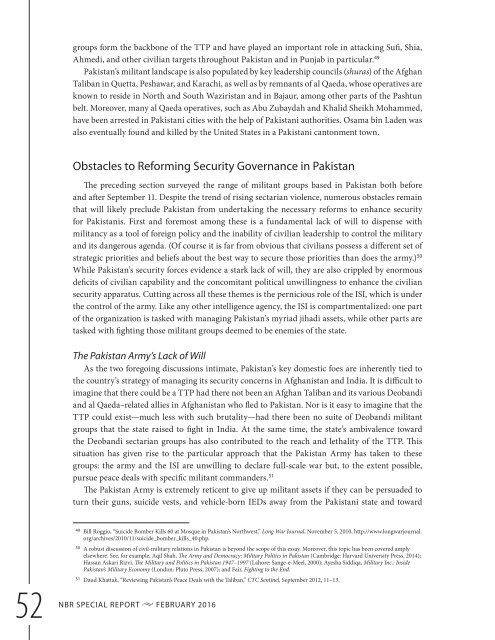pakistan’s
SR55_Mapping_Pakistan_February2016
SR55_Mapping_Pakistan_February2016
You also want an ePaper? Increase the reach of your titles
YUMPU automatically turns print PDFs into web optimized ePapers that Google loves.
groups form the backbone of the TTP and have played an important role in attacking Sufi, Shia,<br />
Ahmedi, and other civilian targets throughout Pakistan and in Punjab in particular. 49<br />
Pakistan’s militant landscape is also populated by key leadership councils (shuras) of the Afghan<br />
Taliban in Quetta, Peshawar, and Karachi, as well as by remnants of al Qaeda, whose operatives are<br />
known to reside in North and South Waziristan and in Bajaur, among other parts of the Pashtun<br />
belt. Moreover, many al Qaeda operatives, such as Abu Zubaydah and Khalid Sheikh Mohammed,<br />
have been arrested in Pakistani cities with the help of Pakistani authorities. Osama bin Laden was<br />
also eventually found and killed by the United States in a Pakistani cantonment town.<br />
Obstacles to Reforming Security Governance in Pakistan<br />
The preceding section surveyed the range of militant groups based in Pakistan both before<br />
and ater September 11. Despite the trend of rising sectarian violence, numerous obstacles remain<br />
that will likely preclude Pakistan from undertaking the necessary reforms to enhance security<br />
for Pakistanis. First and foremost among these is a fundamental lack of will to dispense with<br />
militancy as a tool of foreign policy and the inability of civilian leadership to control the military<br />
and its dangerous agenda. (Of course it is far from obvious that civilians possess a different set of<br />
strategic priorities and beliefs about the best way to secure those priorities than does the army.) 50<br />
While Pakistan’s security forces evidence a stark lack of will, they are also crippled by enormous<br />
deficits of civilian capability and the concomitant political unwillingness to enhance the civilian<br />
security apparatus. Cutting across all these themes is the pernicious role of the ISI, which is under<br />
the control of the army. Like any other intelligence agency, the ISI is compartmentalized: one part<br />
of the organization is tasked with managing Pakistan’s myriad jihadi assets, while other parts are<br />
tasked with fighting those militant groups deemed to be enemies of the state.<br />
The Pakistan Army’s Lack of Will<br />
As the two foregoing discussions intimate, Pakistan’s key domestic foes are inherently tied to<br />
the country’s strategy of managing its security concerns in Afghanistan and India. It is difficult to<br />
imagine that there could be a TTP had there not been an Afghan Taliban and its various Deobandi<br />
and al Qaeda–related allies in Afghanistan who fled to Pakistan. Nor is it easy to imagine that the<br />
TTP could exist—much less with such brutality—had there been no suite of Deobandi militant<br />
groups that the state raised to fight in India. At the same time, the state’s ambivalence toward<br />
the Deobandi sectarian groups has also contributed to the reach and lethality of the TTP. This<br />
situation has given rise to the particular approach that the Pakistan Army has taken to these<br />
groups: the army and the ISI are unwilling to declare full-scale war but, to the extent possible,<br />
pursue peace deals with specific militant commanders. 51<br />
The Pakistan Army is extremely reticent to give up militant assets if they can be persuaded to<br />
turn their guns, suicide vests, and vehicle-born IEDs away from the Pakistani state and toward<br />
52<br />
NBR<br />
49 Bill Roggio, “Suicide Bomber Kills 60 at Mosque in Pakistan’s Northwest,” Long War Journal, November 5, 2010, http://www.longwarjournal.<br />
org/archives/2010/11/suicide_bomber_kills_40.php.<br />
50 A robust discussion of civil-military relations in Pakistan is beyond the scope of this essay. Moreover, this topic has been covered amply<br />
elsewhere. See, for example, Aqil Shah, The Army and Democracy: Military Politics in Pakistan (Cambridge: Harvard University Press, 2014);<br />
Hassan Askari Rizvi, The Military and Politics in Pakistan 1947–1997 (Lahore: Sange-e-Meel, 2000); Ayesha Siddiqa, Military Inc.: Inside<br />
Pakistan’s Military Economy (London: Pluto Press, 2007); and Fair, Fighting to the End.<br />
51 Daud Khattak, “Reviewing Pakistan’s Peace Deals with the Taliban,” CTC Sentinel, September 2012, 11–13.<br />
SPECIAL REPORT u FEBRUARY 2016



